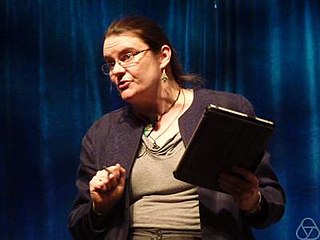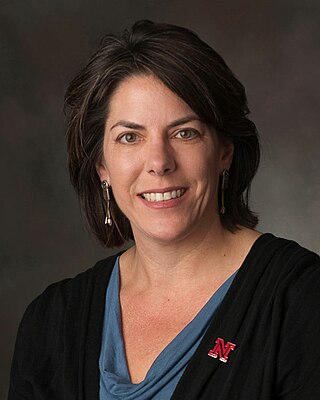Related Research Articles

The Mathematical Association of America (MAA) is a professional society that focuses on mathematics accessible at the undergraduate level. Members include university, college, and high school teachers; graduate and undergraduate students; pure and applied mathematicians; computer scientists; statisticians; and many others in academia, government, business, and industry.
Carl Bernard Pomerance is an American number theorist. He attended college at Brown University and later received his Ph.D. from Harvard University in 1972 with a dissertation proving that any odd perfect number has at least seven distinct prime factors. He joined the faculty at the University of Georgia, becoming full professor in 1982. He subsequently worked at Lucent Technologies for a number of years, and then became a distinguished Professor at Dartmouth College.

Herbert Saul Wilf was an American mathematician, specializing in combinatorics and graph theory. He was the Thomas A. Scott Professor of Mathematics in Combinatorial Analysis and Computing at the University of Pennsylvania. He wrote numerous books and research papers. Together with Neil Calkin he founded The Electronic Journal of Combinatorics in 1994 and was its editor-in-chief until 2001.
The Deborah and Franklin Tepper Haimo Awards for Distinguished College or University Teaching of Mathematics are awards given by the Mathematical Association of America to recognize college or university teachers "who have been widely recognized as extraordinarily successful and whose teaching effectiveness has been shown to have had influence beyond their own institutions." The Haimo awards are the highest teaching honor bestowed by the MAA. The awards were established in 1993 by Deborah Tepper Haimo and named after Haimo and her husband Franklin Haimo. After the first year of the award up to three awards are given every year.
Judith Victor Grabiner is an American mathematician and historian of mathematics, who is Flora Sanborn Pitzer Professor Emerita of Mathematics at Pitzer College, one of the Claremont Colleges. Her main interest is in mathematics in the eighteenth and nineteenth centuries.

Jennifer J. Quinn is an American mathematician specializing in combinatorics, and professor of mathematics at the University of Washington Tacoma. She sits on the board of governors of the Mathematical Association of America, and is serving as its president for the years 2021 and 2022. From 2004 to 2008 she was co-editor of Math Horizons.
Doris J. Schattschneider is an American mathematician, a retired professor of mathematics at Moravian College. She is known for writing about tessellations and about the art of M. C. Escher, for helping Martin Gardner validate and popularize the pentagon tiling discoveries of amateur mathematician Marjorie Rice, and for co-directing with Eugene Klotz the project that developed The Geometer's Sketchpad.

Judy Leavitt Walker is an American mathematician. She is the Aaron Douglas Professor of Mathematics at the University of Nebraska–Lincoln, where she chaired the mathematics department from 2012 through 2016 and currently serves as the Associate Vice Chancellor for Faculty Affairs. Her research is in the area of algebraic coding theory.
Terrie Christine Stevens, also known as T. Christine Stevens, is an American mathematician whose research concerns topological groups, the history of mathematics, and mathematics education. She is also known as the co-founder of Project NExT, a mentorship program for recent doctorates in mathematics, which she directed from 1994 until 2009.
Deborah Tepper Haimo (1921–2007) was an American mathematician who became president of the Mathematical Association of America (MAA). Her research concerned "classical analysis, in particular, generalizations of the heat equation, special functions, and harmonic analysis".
Aparna W. Higgins is a mathematician known for her encouragement of undergraduate mathematicians to participate in mathematical research. Higgins originally specialized in universal algebra, but her more recent research concerns graph theory, including graph pebbling and line graphs. She is a professor of mathematics at the University of Dayton.
Suzanne Ingrid Dorée is a professor of mathematics at Augsburg University, where she is also chair of the Department of Mathematics, Statistics, and Computer Science,. She is chair of the Congress of the Mathematical Association of America and, as such, serves on its board of directors and the Section Visitors Program. Her doctoral research concerned group theory; she has also published in mathematics education.
Rhonda Lee Hatcher is an American mathematician whose research topics include analytic number theory and L-functions as well as topics in recreational mathematics. She is an emeritus associate professor of mathematics at Texas Christian University.
Karen Rhea is an American mathematics educator, a Collegiate Lecturer Emerita in the mathematics department of the University of Michigan. Before joining the University of Michigan faculty, she was on the faculty at the University of Southern Mississippi.
Ezra Abraham "Bud" Brown is an American mathematician active in combinatorics, algebraic number theory, elliptic curves, graph theory, expository mathematics and cryptography. He spent most of his career at Virginia Tech where he is now Alumni Distinguished Professor Emeritus of Mathematics.
Donald Steven Passman is an American mathematician, specializing in ring theory, group theory, and Lie algebra theory.
Carol Smith Schumacher is a Bolivian-born American mathematician specializing in real analysis, a mathematics educator, and a textbook author. She is a professor of mathematics at Kenyon College, and vice president of the Mathematical Association of America.
Lisa Mantini is an American mathematician.
Ranjan Roy was an Indian-born American mathematician. He spent most of his career as a professor at Beloit College.
Adriana Julia Salerno Domínguez is a Venezuelan-American mathematician, a professor of mathematics at Bates College, and a program director at the National Science Foundation. Her research interests include arithmetic geometry and arithmetic dynamics in number theory. She is also a mathematics blogger, the co-founder of the American Mathematical Society blogs "Ph.D. plus epsilon" and "inclusion/exclusion".
References
- 1 2 3 Notable Women in Mathematics, a Biographical Dictionary, edited by Charlene Morrow and Teri Perl, Greenwood Press, 1998. pp 90–93.
- 1 2 3 Curriculum vitae Archived 2020-04-07 at the Wayback Machine , retrieved 2014-06-17.
- ↑ Joan Prince Hutchinson at the Mathematics Genealogy Project
- ↑ "Editorial Board". Journal of Graph Theory. Wiley. doi:10.1002/(ISSN)1097-0118 . Retrieved 27 February 2016.
- ↑ "Celebrating the Mathematical Inspirations of Michael O. Albertson". CoNE Revisited. Smith College. Archived from the original on 15 December 2015. Retrieved 27 February 2016.
- ↑ Review of Discrete Mathematics with Algorithms by David A. Klarner (1989), MR 0950858
- ↑ "Carl. B. Allendoerfer Awards". Mathematical Association of America. MAA. Retrieved 26 February 2016.
- ↑ Cipra, Barry Arthur (1993). What's Happening in the Mathematical Sciences. Amer. Math. Soc.coume=1. pp. 43–46. ISBN 978-0821889992.
- ↑ Stewart, I. (August 1997). "Mathematical Recreations". Scientific American. 277 (2): 86–88. doi:10.1038/scientificamerican0897-86 . Retrieved 27 February 2016.Stewart, I. (September 1997). "Mathematical Recreations". Scientific American. 227 (3): 92–94. doi:10.1038/scientificamerican0997-92 . Retrieved 27 February 2016.
- ↑ "Section Teaching Awards". Mathematical Association of America. MAA. Archived from the original on 11 March 2016. Retrieved 26 February 2016.
- ↑ "Recipients of the Deborah and Franklin Tepper Haimo Award for Distinguished College or University Teaching of Mathematics; Mathematical Association of America". www.maa.org. Archived from the original on 2024-06-08. Retrieved 2024-10-07.
{{cite web}}: CS1 maint: bot: original URL status unknown (link) - ↑ "Deborah and Franklin Tepper Haimo Award". Mathematical Association of America. MAA. Archived from the original on 28 June 2017. Retrieved 26 February 2016.
- ↑ "Graph Theory with Altitude". Topology Atlas. York University. Archived from the original on 4 March 2016. Retrieved 26 February 2016.